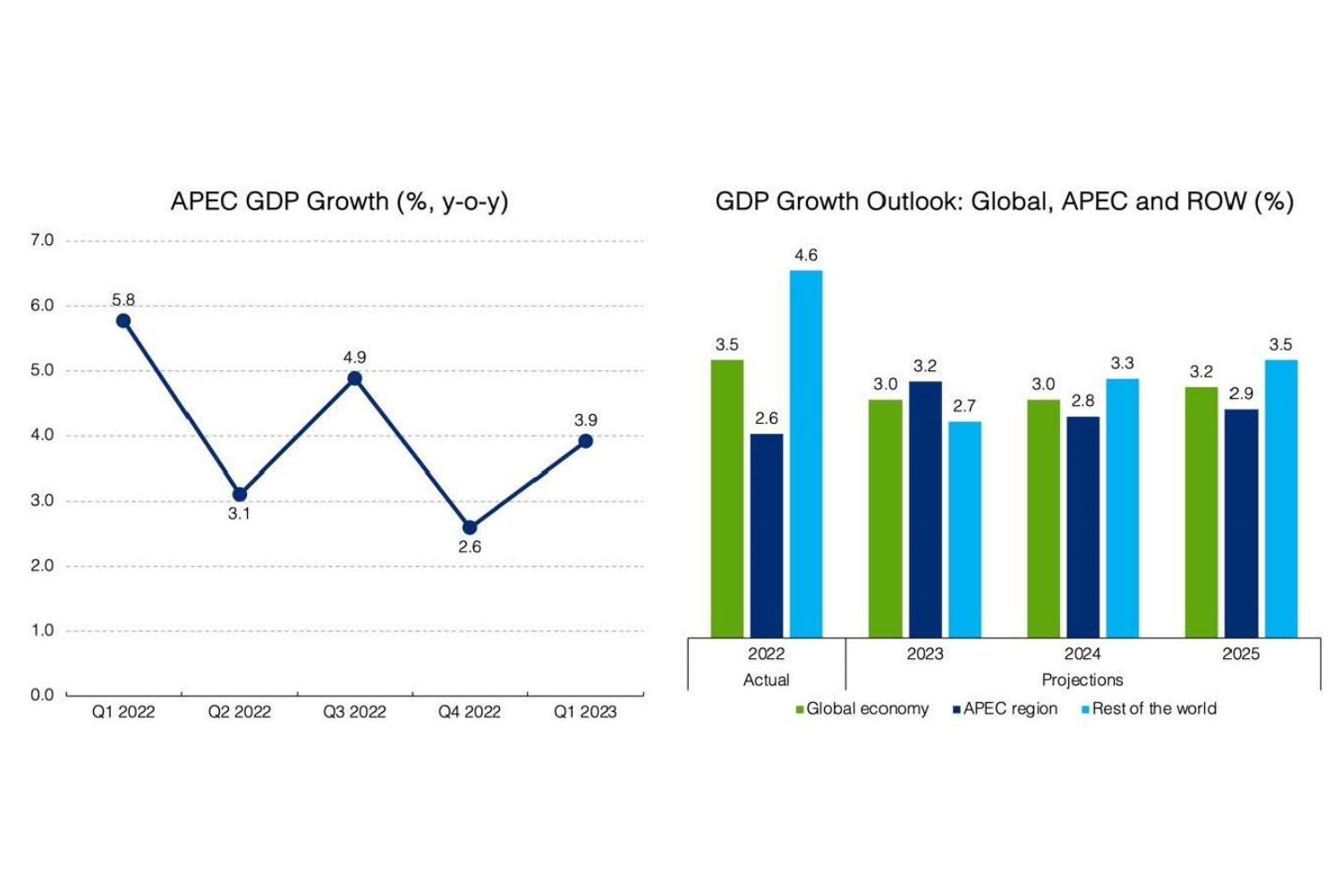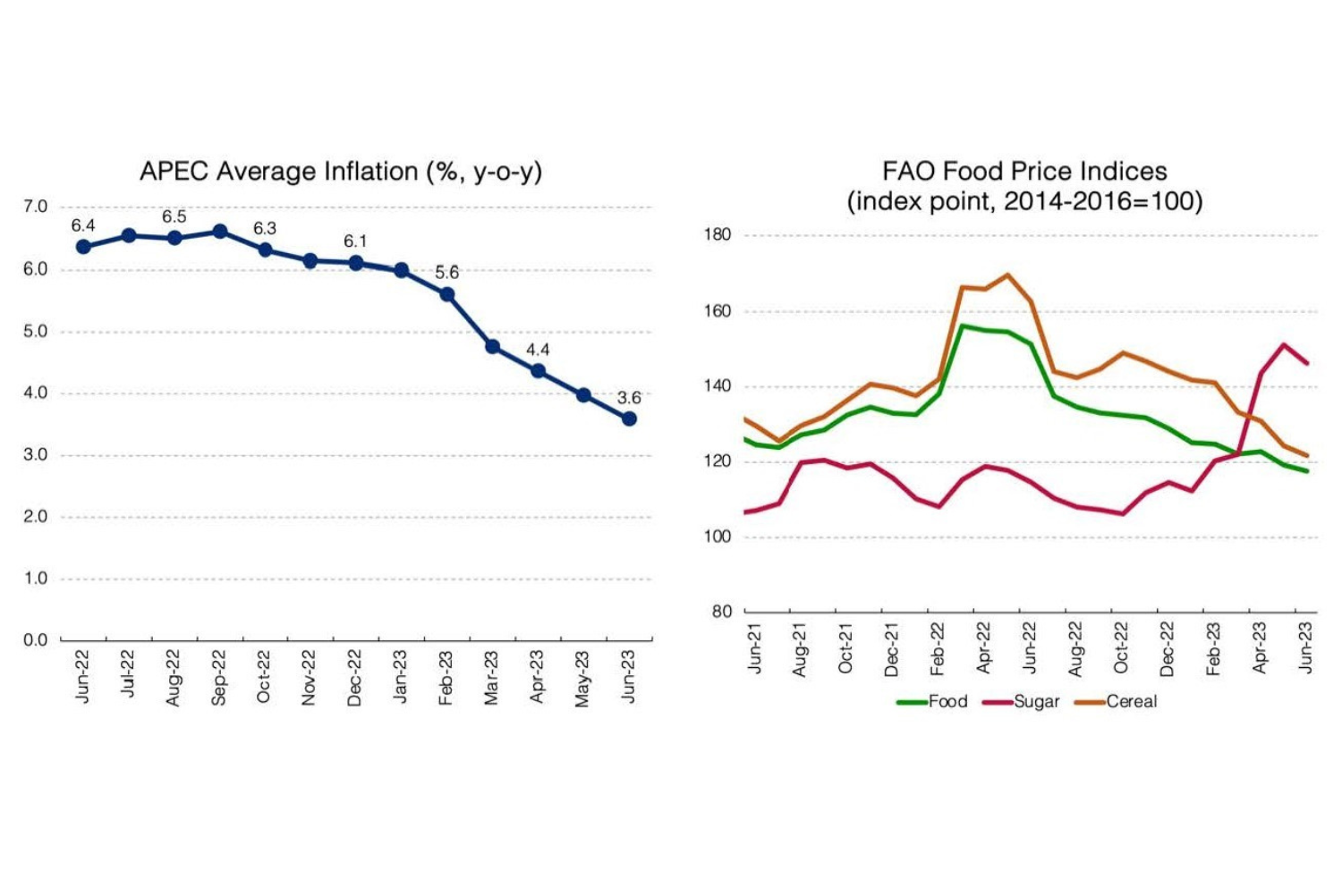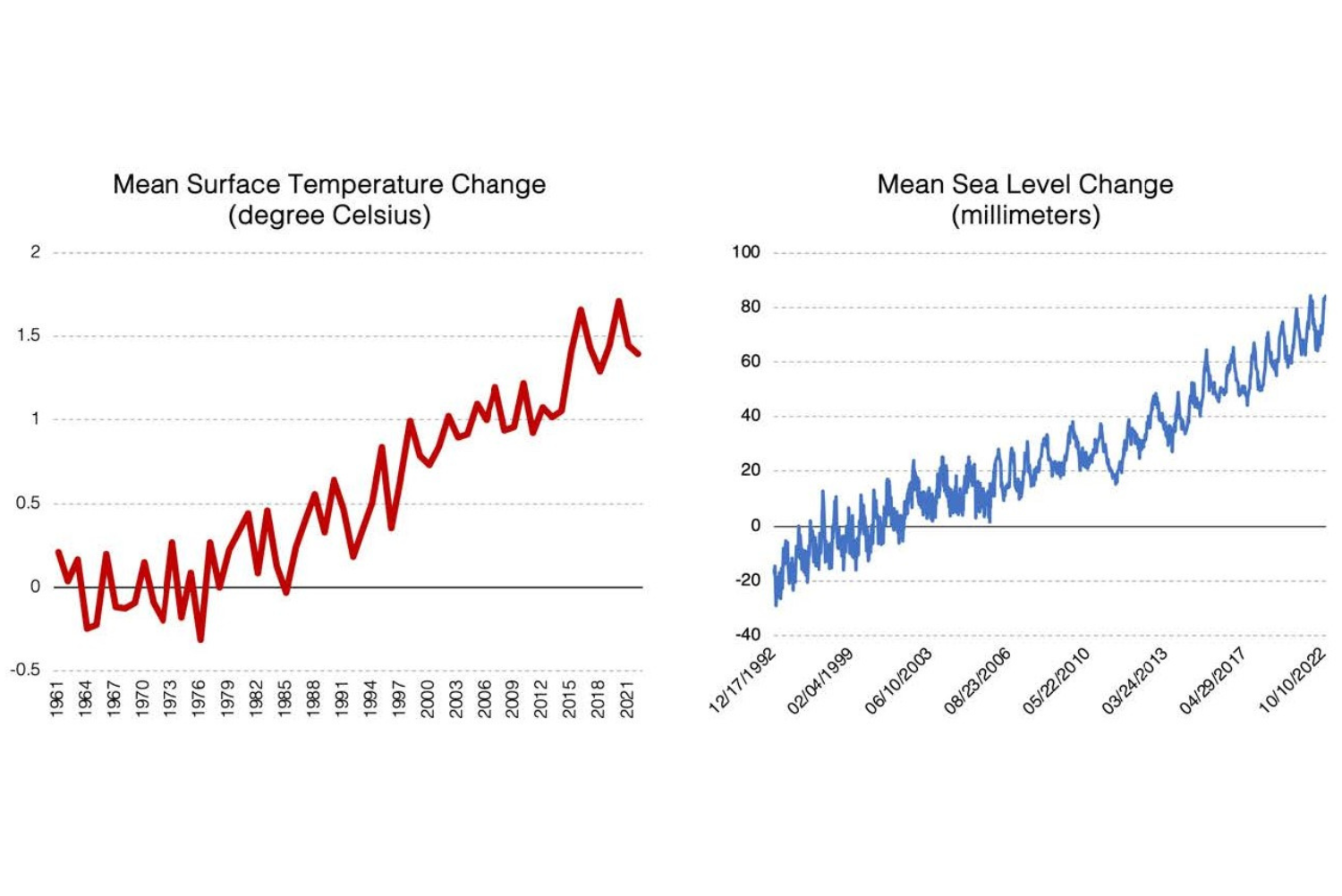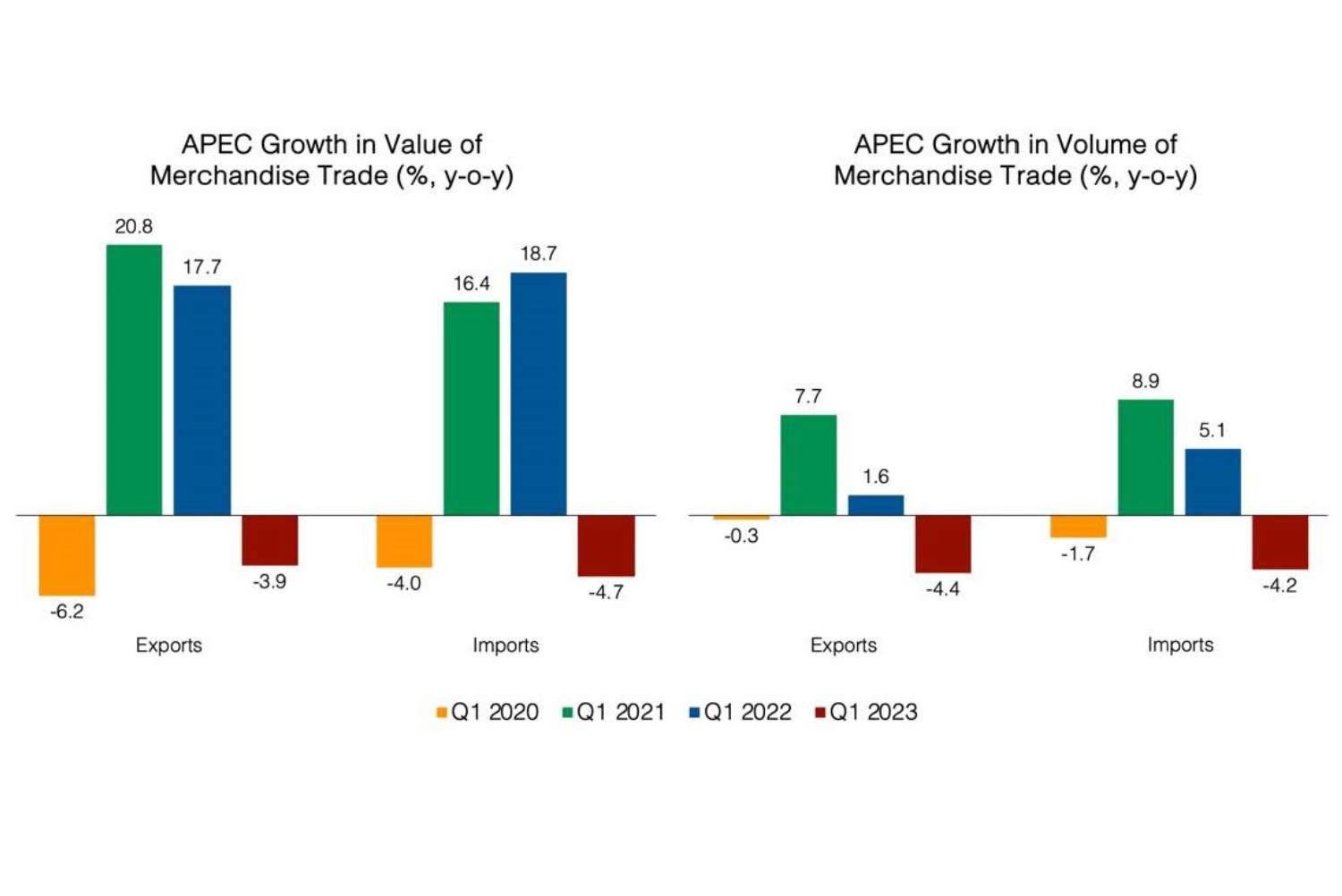Fragile Recovery and Intertwined Challenges

Prevailing uncertainties, warming temperatures and faltering trade
The APEC region tracks a delicate economic recovery amid ongoing uncertainties in the economic and geopolitical landscapes even as extreme weather and trade-restrictive measures add to the challenges.
Risks have moderated as authorities have been taking actions to bring down inflation and address financial turmoil in the US and Europe. However, inflation could rise anew as geopolitical factors and the El Niño weather phenomenon translate to supply shocks and infrastructure damage. Added to these are debt sustainability concerns, aggravated by high interest rates, which have increased economic vulnerabilities. The accumulation of trade-restrictive measures amid geoeconomic fragmentation could adversely affect trade growth.
Moderated economic growth and reduced inflation rates
The APEC region moderated by 3.9 percent in Q1 2023, lower than the growth rate of 5.8 percent in Q1 2022. Compared to the projections in the May 2023 APEC Regional Trends Analysis, APEC GDP growth is expected to increase by 0.1 percentage point to 3.2 percent in 2023, with growth in 2023 and 2024 remaining unchanged at 2.8 percent and 2.9 percent, respectively.
 Source: International Monetary Fund (IMF) World Economic Outlook (WEO) July 2023; Economy sources; APEC PSU (Policy Support Unit) staff calculations
Source: International Monetary Fund (IMF) World Economic Outlook (WEO) July 2023; Economy sources; APEC PSU (Policy Support Unit) staff calculations
Cost-of-living concerns remain, with most monetary authorities implementing interest rate hikes to bring down inflation to 4 percent in Q2 2023 from the 2022 average of 5.9 percent. Ample supplies from the combination of higher production and lower demand, which led to a 22 percent year-on-year decline in Food and Agriculture Organization of the United Nations’ (FAO) food price index so far in 2023 also helped reduce inflation. Energy prices have gone down substantially in the first half of 2023, with crude oil prices declining by 37 percent year-on-year in June 2023 to USD73.3 per barrel while the index for natural gas decreased by 68 percent during the same period. Lower inflation rates are also explained by a reduction in supply-chain costs, with shipping container costs decreasing by 21.1 percent while global average delays for late vessel arrivals are falling back to pre-pandemic levels in June 2023 compared to year-ago levels.
 Source: Economy sources; Food and Agriculture Organization of the United Nations (FAO); APEC PSU staff calculations
Source: Economy sources; Food and Agriculture Organization of the United Nations (FAO); APEC PSU staff calculations
Inflationary risks are not over, El Niño may trigger price increases and affect growth prospects
A severe El Niño weather phenomenon, bringing with it droughts, heatwaves, floods, and wildfires could significantly affect prices in two ways. One, it could hurt crop yields, and at the same time, boost demand for energy products with hydroelectric power plants generating lower outputs, resulting in higher global commodity prices for food and fuel. Two, it could damage infrastructure, raising prices of construction materials. Disrupted supply chains from extreme weather conditions could also result in higher prices for affected products.
Historically, severe El Niño episodes have hampered economic growth (Callahan and Mankin, 2023). Specifically, the 1982-1983 and 1997-1998 El Niño events have been linked to global GDP losses of about USD4.1 trillion and USD5.7 trillion, respectively.
Decades of higher carbon dioxide levels in the atmosphere are reflected in warming climate and rising seas. For example, mean surface temperature has risen by about 1.5 degree Celsius in the past five years compared to levels in 1951-1980. Average sea levels have also increased by about 80 millimeters in 2022. These conditions are being intensified by signs of a severe El Niño weather pattern this year, which threatens directly overall agricultural and fishing production, as well as critical infrastructure. These potential damages would have serious negative consequences on growth and development for the succeeding years. Source: IMF Climate Change Dashboard; APEC PSU staff calculations
Source: IMF Climate Change Dashboard; APEC PSU staff calculations
Mixed trends in trade
Uncertainties in the path of inflation and global economic recovery coupled with geopolitical factors have influenced trade performance, policies and relations. Some firms have been changing their supply-chain strategies, while global demand for goods has weakened. Trade-restrictive measures and its potential sustained rise in this context could negatively impact on trade growth. The confluence of these factors has led to a contraction in the volume of APEC merchandise trade of 4.4 percent for exports and 4.2 percent for imports. The growth in the value of merchandise trade has also entered negative territory at -3.9 percent for exports and -4.7 percent for imports. Source: World Trade Organization (WTO) Time Series; APEC PSU staff calculations
Source: World Trade Organization (WTO) Time Series; APEC PSU staff calculations
Latest data from the World Trade Organization (WTO) showed that trade-facilitating measures in APEC continue to outnumber trade-restrictive measures. However, the accumulated number of trade-restrictive measures in force in APEC has been on the rise and has reached 480 as of May 2023. Furthermore, trade remedies in force are growing, mainly anti-dumping measures and countervailing duties, reaching about 947 in APEC. These increases in trade-restrictive measures and trade remedies are a worrying sign, affecting negatively trade flows on an increasing number of goods.
Latest trade projections by the WTO expect global merchandise trade volume to grow by only 1.7 percent in 2023 and 3.2 percent in 2024.
In contrast, trade in services in APEC has been growing at a faster pace. APEC maintained double-digit expansion in commercial services trade, although slightly lower at 13.8 percent in 2022 compared to 15.7 percent in 2021 for imports and at 12.5 percent in 2022 compared to 16.6 percent in 2021 for exports. Travel services surged significantly to 60 percent for exports and 83 percent for imports from contractionary levels in 2021, while transport services also posted double-digit growth. The travel and transport sector has benefited from a further relaxation of border requirements and pent-up demand.
Policy recommendations
Economic recovery remains fragile, with prevailing inflationary pressures that could be aggravated by severe weather-related patterns, like El Niño. Trade growth is increasingly shaped by policies and changing supply-chain strategies. Elevated levels of debt and interest rates could expose more vulnerabilities and lead to economic weakening. The challenges confronting APEC economies would require prioritizing concerns and allocating needed resources, recognizing that economies are in various stages of development.
- Managing inflation is critical as inflationary pressures remain. World consumer prices are expected to decline to 6.8 percent this year and further down to 5.2 percent in 2024 from as high as 8.7 percent in 2022 (IMF, 2023). Mirroring global trends, APEC inflation could go down to 4.4 percent in 2023 and 2.9 percent in 2024 from the 2022 level of 5.9 percent. However, it remains crucial for central banks to keep a watchful eye on inflationary pressures, especially as they interact with potential supply shocks such as extreme weather. Maintaining monetary policy agility is important to be able to adjust policies when necessary.
- Restoring fiscal space. Having sufficient room to support the growth requirements of the economy is important to sustain the post-pandemic recovery. There are a variety of ways to restore fiscal space. Fiscal consolidation involves prudent spending by reducing non-essential expenditures and streamlining public services. Economies can also implement a targeted approach by supporting the vulnerable and prioritizing productive spending such as investments in infrastructure, education and healthcare to boost productivity. Restructuring or refinancing public debt could help manage debt. In the medium-term, fiscal reforms are needed to increase revenues and improve the efficiency of public sector entities.
- Mitigating and adapting to climate change. Although the interlinkages between macroeconomic conditions and climate change are complex, it is becoming increasingly clear that more frequent and severe natural disasters could devastate economies by disrupting supply chains, creating financial risks, damaging infrastructure, and increasing spending on relief and recovery efforts, among others. Alongside commitments, policymakers need to intensify efforts towards a significant reduction in carbon emissions by encouraging the use of technologies and approaches to reduce greenhouse gas emissions as well as mitigate climate change and its consequences. This could mean adopting sustainable modes of transportation, improving energy efficiency in homes and across industries, transitioning to renewable energy, using climate-friendly agriculture practices, promoting circular economy, reducing deforestation, and/or investing in green innovation and research. In addition, governments have to invest in infrastructure to get ready to face more extreme weather patterns.
The intertwined challenges of economic fragility, geopolitical tensions and climate change that the APEC region is facing require a more decisive role for multilateral cooperation. Fostering open dialogue, close coordination and collective action could help economies to focus efforts on economic and environmental considerations to build a sustainable and resilient future for the APEC region.
***
Rhea Crisologo Hernando is senior researcher and Carlos Kuriyama is director at the APEC Policy Support Unit.
This article is based on the latest APEC Regional Trends Analysis co-authored with Glacer Niño A. Vasquez.

